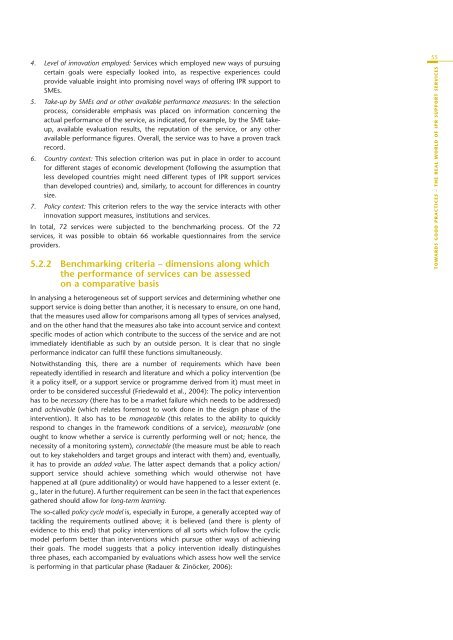Benchmarking National - PRO INNO Europe
Benchmarking National - PRO INNO Europe
Benchmarking National - PRO INNO Europe
You also want an ePaper? Increase the reach of your titles
YUMPU automatically turns print PDFs into web optimized ePapers that Google loves.
4. Level of innovation employed: Services which employed new ways of pursuing<br />
certain goals were especially looked into, as respective experiences could<br />
provide valuable insight into promising novel ways of offering IPR support to<br />
SMEs.<br />
5. Take-up by SMEs and or other available performance measures: In the selection<br />
process, considerable emphasis was placed on information concerning the<br />
actual performance of the service, as indicated, for example, by the SME takeup,<br />
available evaluation results, the reputation of the service, or any other<br />
available performance figures. Overall, the service was to have a proven track<br />
record.<br />
6. Country context: This selection criterion was put in place in order to account<br />
for different stages of economic development (following the assumption that<br />
less developed countries might need different types of IPR support services<br />
than developed countries) and, similarly, to account for differences in country<br />
size.<br />
7. Policy context: This criterion refers to the way the service interacts with other<br />
innovation support measures, institutions and services.<br />
In total, 72 services were subjected to the benchmarking process. Of the 72<br />
services, it was possible to obtain 66 workable questionnaires from the service<br />
providers.<br />
5.2.2 <strong>Benchmarking</strong> criteria – dimensions along which<br />
the performance of services can be assessed<br />
on a comparative basis<br />
In analysing a heterogeneous set of support services and determining whether one<br />
support service is doing better than another, it is necessary to ensure, on one hand,<br />
that the measures used allow for comparisons among all types of services analysed,<br />
and on the other hand that the measures also take into account service and context<br />
specific modes of action which contribute to the success of the service and are not<br />
immediately identifiable as such by an outside person. It is clear that no single<br />
performance indicator can fulfil these functions simultaneously.<br />
Notwithstanding this, there are a number of requirements which have been<br />
repeatedly identified in research and literature and which a policy intervention (be<br />
it a policy itself, or a support service or programme derived from it) must meet in<br />
order to be considered successful (Friedewald et al., 2004): The policy intervention<br />
has to be necessary (there has to be a market failure which needs to be addressed)<br />
and achievable (which relates foremost to work done in the design phase of the<br />
intervention). It also has to be manageable (this relates to the ability to quickly<br />
respond to changes in the framework conditions of a service), measurable (one<br />
ought to know whether a service is currently performing well or not; hence, the<br />
necessity of a monitoring system), connectable (the measure must be able to reach<br />
out to key stakeholders and target groups and interact with them) and, eventually,<br />
it has to provide an added value. The latter aspect demands that a policy action/<br />
support service should achieve something which would otherwise not have<br />
happened at all (pure additionality) or would have happened to a lesser extent (e.<br />
g., later in the future). A further requirement can be seen in the fact that experiences<br />
gathered should allow for long-term learning.<br />
The so-called policy cycle model is, especially in <strong>Europe</strong>, a generally accepted way of<br />
tackling the requirements outlined above; it is believed (and there is plenty of<br />
evidence to this end) that policy interventions of all sorts which follow the cyclic<br />
model perform better than interventions which pursue other ways of achieving<br />
their goals. The model suggests that a policy intervention ideally distinguishes<br />
three phases, each accompanied by evaluations which assess how well the service<br />
is performing in that particular phase (Radauer & Zinöcker, 2006):<br />
55<br />
TOWARDS GOOD PRACTICES – THE REAL WORLD OF IPR SUPPORT SERVICES
















